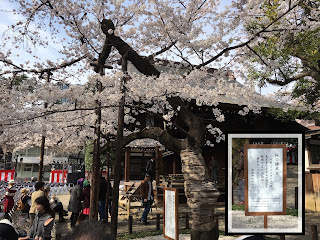 |
| The official sample cherry tree at Yasukuni Shrine, Tokyo |
On Sunday (April 2nd) came the official announcement that Someiyoshino (the most popular variety of cherry blossom - white with a tinge of pink) were in full bloom in Tokyo, 12 days after they began flowering. In Japan,
sakura - the generic name for cherry tree - are observed with scientific precision and the Japanese Meteorological Agency (JMA) publishes detailed
maps and forecasts that allow people to track the
sakura zensen (cherry blossom front) as it moves north. The picture on the left shows the sample specimen
tree (hyōhonboku) located at Yasukuni Shrine in Tokyo which is used by the JMA as the basis for their announcements. There are 96 such designated trees throughout the nation. People keep a close watch on this information when planning their "cherry blossom viewing" (
hanami =花見) parties. But despite the image of
sakura as being deeply symbolic for the Japanese, people attending
hanami parties are usually more interested in eating and drinking than admiring the blossoms. This is captured in the phrase
hana yori dango - literally "(sweet) dumplings over flowers," carrying the general meaning that practical things are more important than aesthetics!
 |
| People enjoying "Hanami" Parties at Yasukuni Shrine (2nd from left) and Boating at Chidorigafuchi (3rd from left), both prime-viewing spots for cherry blossoms in Tokyo. Note the five petals each with a distinctive "nick" at the top of the petal |
Incredibly, cherry blossom data is available as far back as the
9th century for Kyoto - reflecting the fact that
hanami has long been a popular cultural past-time for the Japanese. While the average peak bloom has consistently been between April 10th and 20th since the 1800s, recent years have seen a dramatic drop. In the past few years especially, the flowering (
kaika =開花) and full bloom (
mankai=満開) dates have become noticeably
earlier, thought to be a sympton of global warming. For example, in the 1960s, flowering typically began at the start of April in Tokyo, and thus the blooms were closely
associated with school and university entrance ceremonies. Now, the opening of the buds occurs during graduation
ceremonies which are held near the end of March (
mankai was March 22nd in Tokyo in 2021). Moreover, the gap
between
kaika and
mankai has also grown longer since (somewhat non-intuitively) the period between flowering and reaching full bloom is longer in hotter climes (such as Kyushu) than colder ones (such as Hokkaido).

